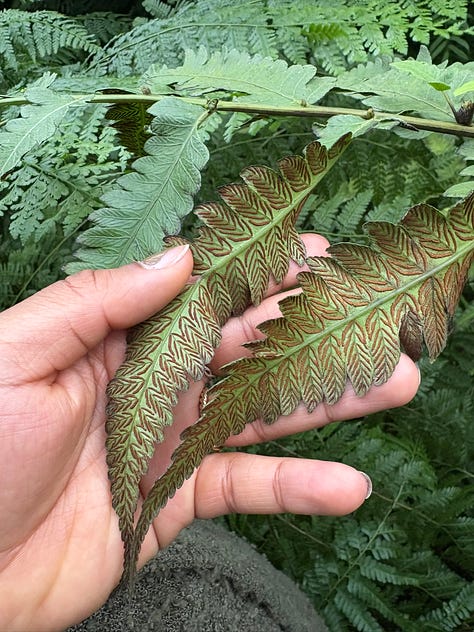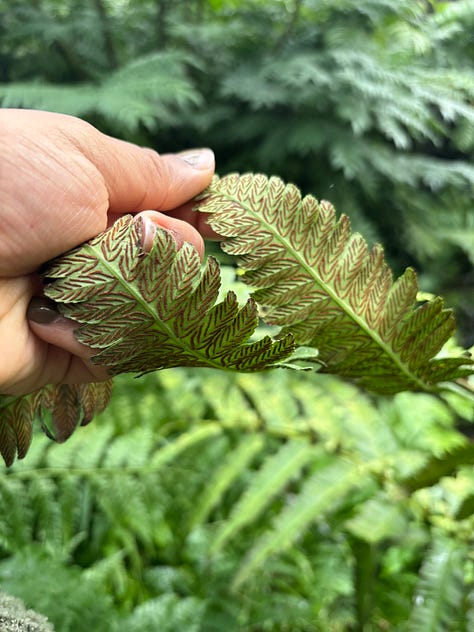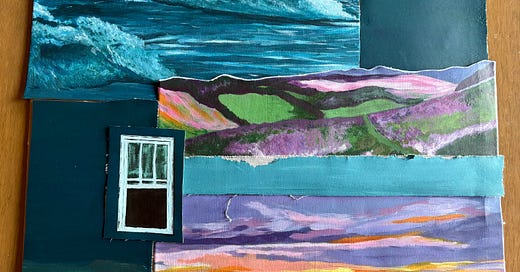Dear friend,
I recently stood at my kitchen table and slowly ripped apart two of my paintings. I pulled the stretched canvas from its wooden frame, gingerly collecting the silver staples that dislodged in the process. I ran scissors along the pockets of color and shapes that pleased me and discarded the rest.
As I moved further into a new art class focused on producing a series of three paintings, I dutifully went to the local art studio. Applying paint to canvas. Putting in the hours. In my growing love for painting, I found myself ensnared in the very things I seek to escape through art: obligation, expectation, responsibility, and the quest to be “good.”
With each slice of the scissors I liberate something from the frame. I challenge something within myself. I lay out each fragment and welcome curiosity: What are you now? What else do you want to be?
Last year, I read two of Alice Walker’s essays exploring the life and death of the luminary Harlem Renaissance writer and anthropologist, Zora Neale Hurston. In her essay “Looking for Zora” where Walker, describes going back to Hurston’s hometown in Florida to find her grave, unmarked in an overgrown field.
The scholar and writer, Saidiyah Hartman, details the similar fates of young Black women in early-20th century New York and Philadelphia, in her book Wayward Lives, Beautiful Experiments. As I read the stories of their quests for delight, tenderness, and pleasure, an old fear creeped up my spine. My upbringing—sometimes explicitly and often subliminally—was about escaping such a fate. To fall out of line which meant to fall into ruin was to be avoided at all costs. That “ruin” (the arms of volatile lovers, the dominion of police, the cycle of debt, the grip of addiction) were all things that could supposedly be avoided through prayer and piousness. By being home before the streetlights. By studying the rules and following them.
It not only lives in my psyche but in my body. The somatic lessons shape-shift to modern scenarios. The same ideology that helped my grandmother survive poverty in the Jim Crow South, shows up on my painting canvas: Be neat and fastidious. Work hard and follow the rules. Listen to the person in charge.
Humming beneath it all is a stern and unwavering warning: To preserve yourself, you must deny yourself.
Anything else was a choice to walk toward suffering—toward the unmarked grave, the prison cell. Both Walker and Hartman defy this belief in their bold journey to the archive of resistance that prefaces tragedy. Hartman defiantly re-defines this “waywardness” as:
“The practice of possibility at a time when all roads, except the ones created by smashing out, are foreclosed. It obeys no rules and abides no authorities. It is unrepentant. It traffics in occult visions of other worlds and dreams of a different kind of life. Waywardness is an ongoing exploration of what might be; it is an improvisation with the terms of social existence, when the terms have already been dictated, when there is little room to breathe, when you have been sentenced to a life of servitude, when the house of bondage looms in whatever direction you move. It is the untiring practice of trying to live when you were never meant to survive.”
Walker buys her literary ancestor a headstone. Hurston speculates about the dreams and longings of black girls trapped in the flash of a mugshot. They are calling out in a language on the verge of distinction. In an octave almost too low to hear. Whose syntax and rhythm I am trying to find under my own tongue. A dialect one might call audacity.
In Hurston’s famous essay, “How It Feels to Be Colored Me,” she rebukes the racism and colorism she experiences in the world, writing:
“No, I do not weep at the world—I am too busy sharpening my oyster knife.”
Lately, I have been thinking about what comes after the weeping. I do weep for the world (I believe Hurston did too, how could she not?), but there is a lucid moment once the weeping subsides where we can choose to subdue ourselves or pick up the metaphorical oyster knife and go about sharpening it; moving with surgical-like precision in pursuit of something worth living for.



Oysters are hard-shelled soft-bodied creatures that on occasion produce pearls. The pearl itself is a defense mechanism against irritants like parasites that might try to enter their shell. The irritant is coated in layers of nacre or “mother of pearl.”
In its quest to survive, the oyster creates a coveted beauty.
I’m always stunned by how much of the natural world makes what is functional, fabulous. A fern I encountered last month had the most intricate spores under each leaf: brown lines repeating perfectly with intimate curves like stitches. These sites of mundane reproduction, choose to display themselves as a visual treasure, flooding my eyes with beauty.
I am thinking about Hurston, a young Black woman oyster knife in hand, cracking open the shell of a luxurious afternoon snack or stumbling upon a pearl, white and smooth in her palm; Hurston and every woman like her stringing together these glossy saps of survival.
A necklace, an inheritance, heavy around my neck.
With love,
Jas








Beautiful - this gave me something I needed today. Thank you 🦪
Discovered this essay (and your Substack) today and oh, it resonated. Thank you for sharing!